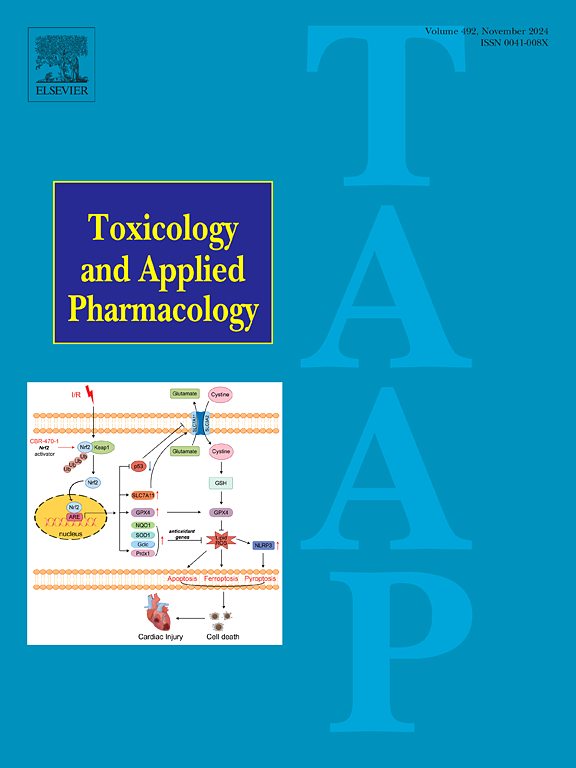棕榈酸和脂多糖诱导巨噬细胞分泌TNFα,抑制脂肪细胞褐变调节因子和线粒体呼吸
IF 3.4
3区 医学
Q2 PHARMACOLOGY & PHARMACY
引用次数: 0
摘要
肥胖及其相关的促炎活动对代谢功能障碍有重要影响。相反,白色脂肪组织(WAT)的褐色化通常会改善代谢健康。我们之前的研究表明,巨噬细胞来源的促炎细胞因子抑制了饮食诱导肥胖小鼠中褐色肾上腺素能受体β3 (Adrb3)和过氧化物酶体增殖激活受体γ (Pparg)的关键调节因子,以及能量代谢介质-胰岛素受体底物1 (Irs1)和激素敏感脂肪酶(Lipe)。为了探索这一机制,我们建立了一个体外模型,使用暴露于棕榈酸(PA)和/或脂多糖(LPS)的RAW264.7巨噬细胞和3T3-L1脂肪细胞。PA (200 μM)和LPS (1.0 μg/ml)协同促进巨噬细胞M1极化和促炎细胞因子的分泌,以肿瘤坏死因子-α (TNFα)、C-C基序趋化因子配体2 (CCL2)、CCL5和白细胞介素-6 (IL-6)为主。当LPS浓度≥0.01 μg/ml时,巨噬细胞Adrb3、Pparg、Irs1和Lipe的表达均显著下调。在生理相关LPS水平(≤0.001 μg/ml)下,pa处理的巨噬细胞培养基对这些基因的抑制作用大于对照组。在这些细胞因子中,TNFα是主要的调节因子,显著降低了四种关键调节因子的表达。此外,TNFα处理的脂肪细胞解偶联蛋白1 (Ucp1)表达和线粒体呼吸均显著降低。这些发现表明,暴露于肥胖相关因子(PA和LPS)诱导巨噬细胞来源的TNFα,从而抑制脂肪细胞的褐变和线粒体功能。这一机制可能为针对TNFα的新的治疗策略提供信息,以减轻肥胖相关的代谢紊乱。本文章由计算机程序翻译,如有差异,请以英文原文为准。
Palmitic acid and lipopolysaccharide induce macrophage TNFα secretion, suppressing browning regulators and mitochondrial respiration in adipocytes
Obesity and its associated pro-inflammatory activity contribute significantly to metabolic dysfunction. In contrast, browning of white adipose tissue (WAT) generally improves metabolic health. Our prior research suggested that macrophage-derived pro-inflammatory cytokines suppress key regulators of browning—adrenergic receptor β3 (Adrb3) and peroxisome proliferator-activated receptor γ (Pparg)—as well as energy metabolism mediators—insulin receptor substrate 1 (Irs1) and hormone-sensitive lipase (Lipe)—in diet-induced obese mice. To explore this mechanism, we developed an in vitro model using RAW264.7 macrophages and 3T3-L1 adipocytes exposed to palmitic acid (PA) and/or lipopolysaccharide (LPS). PA (200 μM) and LPS (1.0 μg/ml) synergistically promoted M1 polarization of macrophages and secretion of pro-inflammatory cytokines, with tumor necrosis factor-α (TNFα), C-C motif chemokine ligand 2 (CCL2), CCL5, and interleukin-6 (IL-6) being predominant. Conditioned media from both control and PA-treated macrophages, when exposed to LPS ≥0.01 μg/ml, significantly downregulated Adrb3, Pparg, Irs1, and Lipe in adipocytes. At physiologically relevant LPS levels (≤0.001 μg/ml), PA-treated macrophage media exerted greater suppression of these genes than controls. Among the cytokines, TNFα emerged as the primary mediator, significantly reducing expression of the four key regulators. Furthermore, adipocytes treated with TNFα exhibited significant reductions in both uncoupling protein 1 (Ucp1) expression and mitochondrial respiration. These findings demonstrate that exposure to obesity-associated factors (PA and LPS) induces macrophage-derived TNFα, which suppresses browning and mitochondrial function in adipocytes. This mechanism may inform new therapeutic strategies targeting TNFα to alleviate obesity-related metabolic disorders.
求助全文
通过发布文献求助,成功后即可免费获取论文全文。
去求助
来源期刊
CiteScore
6.80
自引率
2.60%
发文量
309
审稿时长
32 days
期刊介绍:
Toxicology and Applied Pharmacology publishes original scientific research of relevance to animals or humans pertaining to the action of chemicals, drugs, or chemically-defined natural products.
Regular articles address mechanistic approaches to physiological, pharmacologic, biochemical, cellular, or molecular understanding of toxicologic/pathologic lesions and to methods used to describe these responses. Safety Science articles address outstanding state-of-the-art preclinical and human translational characterization of drug and chemical safety employing cutting-edge science. Highly significant Regulatory Safety Science articles will also be considered in this category. Papers concerned with alternatives to the use of experimental animals are encouraged.
Short articles report on high impact studies of broad interest to readers of TAAP that would benefit from rapid publication. These articles should contain no more than a combined total of four figures and tables. Authors should include in their cover letter the justification for consideration of their manuscript as a short article.

 求助内容:
求助内容: 应助结果提醒方式:
应助结果提醒方式:


